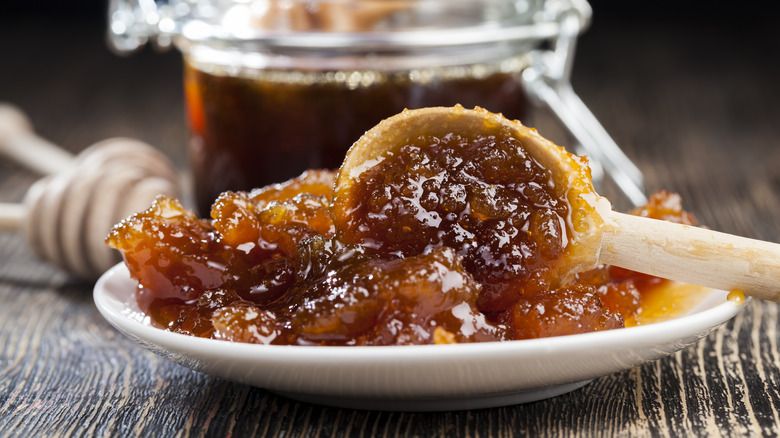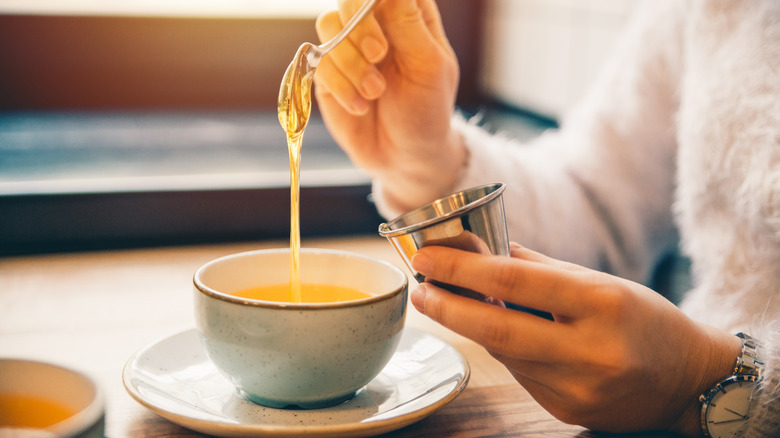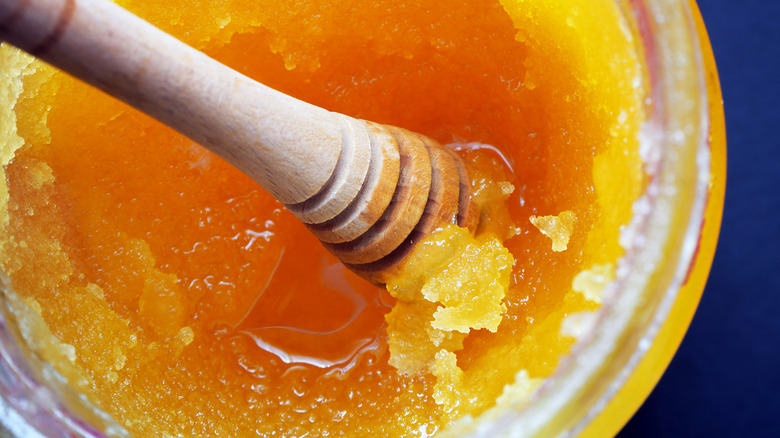The Simple Mistake That's Crystallizing Your Honey
Reaching for your jar of honey only to find it's crystallized can put a damper on trying to add a little sweetness to your favorite foods and beverages. The good news is, this discovery isn't all about bad luck. Chances are, you might be causing your honey to crystallize faster by allowing moisture into the container.
When honey crystallizes, it goes from smooth and liquid to crunchy and clumpy. One way this can happen is if you're using honey to sweeten a cup of tea. If you scoop out honey from the jar with a spoon, use the spoon to stir the honey into your tea, and then return the spoon to the jar for more honey (even if you tap off most of the water), you're adding moisture that can cause crystals to form.
Although double dipping might be tempting, it's a lot more difficult (although possible, more on that later), to salvage crystallized honey than it is to use a new spoon each time you dip into your honey jar. If you know you're guilty of this mistake, you can consider buying honey that comes in a squeezable container (like a honey bear), transferring the honey you have at home into a squeeze bottle, or putting some honey into a small container like a condiment cup or ramekin each time you use it to make tea.
How to prevent honey from crystallizing
Honey crystallizes when the water and sugar it's composed of separate, which results in a semi-solid, crystallized texture. Changes in moisture as well as temperature can cause this to occur. This means that not only do you need to avoid letting water make its way into your honey by double dipping your tea spoon, but you should think twice before storing honey in the fridge, since the cold temperature can cause crystallization to happen faster.
Crystallization is a natural occurrence, and the less processed the honey, the faster it will crystallize. Different types of flower blossoms contain different ratios of glucose to fructose, which will ultimately impact the rate of crystallization because glucose crystallizes more easily. Some types of honey (like Acadia and Tupelo) are naturally runnier than others because they have a higher ratio of fructose.
Direct sunlight is also the enemy when it comes to preventing crystallization. So rather than leaving it out on the counter, you should store honey in a cool, dry place like a cabinet or pantry. Glass containers keep out the most moisture, and you need to seal your container tightly after each use.
Can you still eat honey that's crystallized?
Even if you don't ever let a drop of water hit your honey and you store it correctly, crystallization is still likely to happen over time. The good news is, you can still consume crystallized honey as long as you don't mind not being able to drizzle it, and aren't bothered by the crunchy texture (some people like the added crunch).
The even better news is that if you don't want to eat crystallized honey, you can easily restore it to its liquid state. The best tip for de-crystallizing honey is easier than you thought — just submerge it in a bath of hot water (95 to 105 degrees Fahrenheit for 20 to 30 minutes is best). Again, you don't want water actually touching your honey, so make sure the container is sealed.
You can use this method as many times as you need to, if and when your honey re-crystallizes. Honey doesn't go bad, and it's an ingredient that's often used in small quantities, so don't be surprised if you need to repeat the process more than once on a jar that you hold onto for a while. If you follow these tips, you won't have to panic the next time you want to use this sweet ingredient in a honey lime vinaigrette or a honey bourbon hot toddy.


